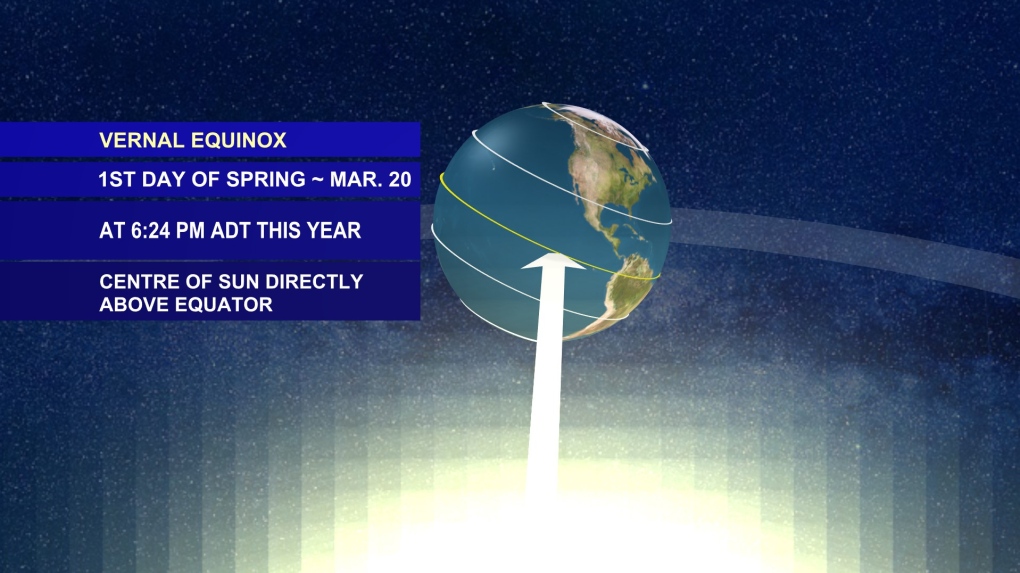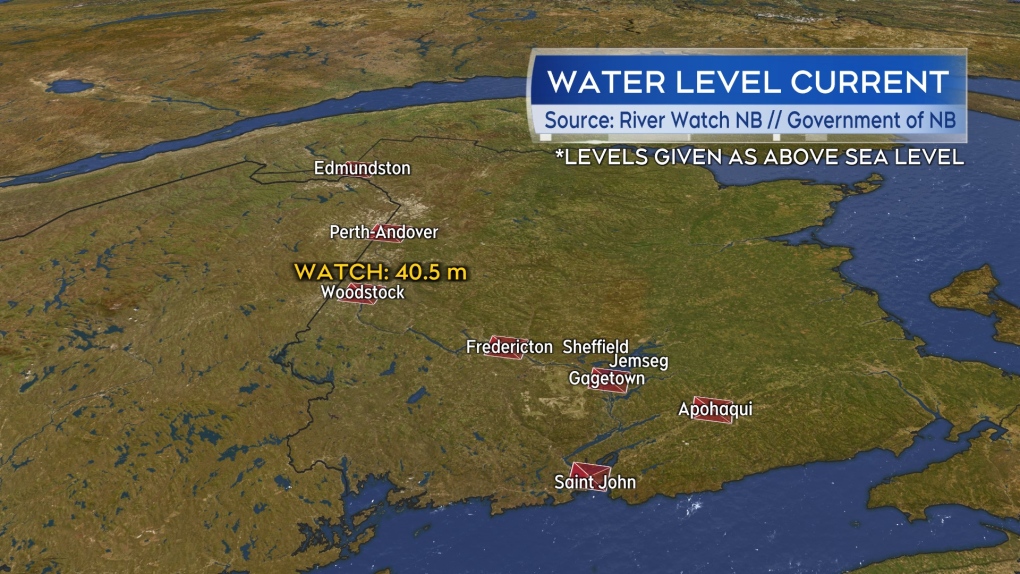Spring equinox arrives Monday evening, marking first day of season
 Environment Canada is not expecting any colder-than-normal conditions on the horizon between March and May. (Pexels)
Environment Canada is not expecting any colder-than-normal conditions on the horizon between March and May. (Pexels)
The spring (vernal) equinox arrives at 6:24 p.m. on Monday. The equinox is the time of the year when the position of the sun passes south to north over the equator.
One may think this would also be the day when there is an equal 12 hours of daylight and 12 hours of night. However, that even split between day and night actually happened a few days ago, on March 17.
The reason for the lag is due to how sunrise and sunset are defined. Sunrise is defined as when the northern edge of the sun crests the horizon, whereas sunset is defined as when the northern edge of the sun sets below the horizon.
 We arrive at the vernal equinox at 6:24 p.m. Monday, which is the astronomical definition for the start of spring.
We arrive at the vernal equinox at 6:24 p.m. Monday, which is the astronomical definition for the start of spring.
RIVER AND FIRE WATCH PROGRAMS
With the arrival of spring, there are some river and fire watch programs now in effect.
This includes the River Watch program in New Brunswick. The temperature trend this week should be favourable for some gradual melt and weakening of the river ice, with temperatures on most days rising above freezing but falling back below at night.
Of course, the big complicating factor every year is the possibility of ice jams.
As of Monday, the only river level reporting station with a water level at watch is the station near Woodstock, N.B. The stages used by New Brunswick's River Watch include advisory, watch, warning and flood, escalating in that order.
No agricultural drought conditions are present for the Maritimes as analysed by Agriculture and Agri-Food Canada as of the end of February.
Nova Scotia and Prince Edward Island enacted their burn restriction programs on March 15. The burn restriction program for New Brunswick comes into effect on the third Monday of April, which will be April 17 this year. Burn restrictions are typically updated by the provinces at 2 p.m. each day. The programs also advise to check with municipal bylaws regarding any open fires.
 The River Watch program is running in New Brunswick. The presence of ice jams and the weather of the week are always big factors when it comes to the risk of flooding during the freshet.
The River Watch program is running in New Brunswick. The presence of ice jams and the weather of the week are always big factors when it comes to the risk of flooding during the freshet.
AVERAGE LAST FROST
For gardeners wondering about frost, that will be a risk for sometime yet.
Areas of the Atlantic coast of Nova Scotia have an average date of last frost that extends from late April into early May. For much of the remainder of the Maritimes, the average date of last frost extends into mid-to-late May. There are some areas, such as the interior of northern Nova Scotia and large area of northern New Brunswick, where the average date of last frost extends into early June. That is likely the case for the Cape Breton Highlands as well, though data on average frost date is lacking for that area.
As average dates of last frost, that does mean there have been many years where a frost has happened past those times.
To get to a 10 per cent or less chance of a frost, you have to wait until early June for most of Nova Scotia and Prince Edward Island, and mid-to-late June for New Brunswick.
"I know many gardeners go by the first full moon of June. It’s not a bad rule of thumb given our frost climatology here in the Maritimes," said CTV Atlantic's Chief Meteorologist Kalin Mitchell.
"The full moon in June is early in the month this year, occurring on June 3."
 Approximate average last frost dates for the Maritimes.
Approximate average last frost dates for the Maritimes.
SPRING WEATHER PREDICTIONS
Seasonal forecasts produced by Environment Canada have the Maritimes expecting near normal temperatures March through May, with the exception of above normal temperatures in parts of southwestern Nova Scotia.
The same predictive system has the Maritimes with below normal amounts of precipitation expected. As a comparison, a seasonal forecast system produced out of the United States has the Maritimes trending slightly towards above normal temperatures and near normal amounts of precipitation through spring.
"I’m leaning towards a spring that will finish with slightly above normal temperatures and near normal amounts of precipitation," said Mitchell.
CTVNews.ca Top Stories

B.C. seeks ban on public drug use, dialing back decriminalization
The B.C. NDP has asked the federal government to recriminalize public drug use, marking a major shift in the province's approach to addressing the deadly overdose crisis.
More than 115 cases of eye damage reported in Ontario after solar eclipse
More than 115 people who viewed the solar eclipse in Ontario earlier this month experienced eye damage after the event, according to eye doctors in the province.
Orca calf that was trapped in B.C. lagoon for weeks swims free
An orca whale calf that has been stranded in a B.C. lagoon for weeks after her pregnant mother died swam out on her own early Friday morning.
Last letters of pioneering climber who died on Everest reveal dark side of mountaineering
George Mallory is renowned for being one of the first British mountaineers to attempt to scale the dizzying heights of Mount Everest during the 1920s. Nearly a century later, newly digitized letters shed light on Mallory’s hopes and fears about ascending Everest.
Sophie Gregoire Trudeau on navigating post-political life, co-parenting and freedom
Sophie Gregoire Trudeau says there is 'still so much love' between her and Prime Minister Justin Trudeau, as they navigate their post-separation relationship co-parenting their three children.
'I was scared': Ontario man's car repossessed after missing two repair loan payments
An Ontario man who took out a loan to pay for auto repairs said his car was repossessed after he missed two payments.
Trump's lawyers try to discredit testimony of prosecution's first witness in hush money trial
Donald Trump's defence team attacked the credibility Friday of the prosecution's first witness in his hush money case, seeking to discredit testimony detailing a scheme between Trump and a tabloid to bury negative stories to protect the Republican's 2016 presidential campaign.
U.S. flight attendant indicted in attempt to record teen girl in airplane bathroom
An American Airlines flight attendant was indicted Thursday after authorities said he tried to secretly record video of a 14-year-old girl using an airplane bathroom last September.
Powerful tornado tears across Nebraska, weather service warns of 'catastrophic' damage
Devastating tornadoes tore across parts of eastern Nebraska and northeast Texas Friday as a multi-day severe thunderstorm event ramped up in the central United States.































